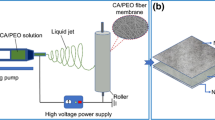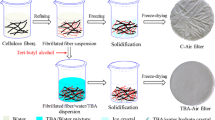Abstract
Air filters are intended to effectively remove particles in the air, and their structure is built of ordinary micro fibrilated cellulose (MFC). Fibrous membrane (FM) was developed using cellulose nanofibers (CNFs) and carbon nanoparticles (CNPs) with different concentrations (0.5, 1.0, and 1.5 wt%) by electrospinning process offer high-performance air filters than those produced of normal MCF due to their larger surface area and smaller pore size. In this study, dust removal effectiveness proved that introducing a membrane containing 1.5 wt% of CNPs significantly improved air filtration while simultaneously increasing pressure drop. The FM had favorable results of the tensile strength (26.48 ± 0.41 MPa), elongation at break (19.23 ± 0.13%), water absorption (28.14 ± 0.22%) and desorption (30.14 ± 0.13%). The findings showed that FM offered 99.99% filtration efficiency, indicating an acceptable technique for constructing inexpensive basis-weight HEPA filters using using CNFs and CNPs as the primary filtration material.







Similar content being viewed by others
Availability of data and materials
All data generated or analyzed during this study are included in this published article.
Change history
21 February 2024
A Correction to this paper has been published: https://doi.org/10.1007/s10570-024-05791-2
References
Bajpai P, Pratima B (2015) Generation of waste in pulp and paper mills. Manag Pulp Paper Mill Waste 2015:9–17
Desai K, Kit K, Li J, Davidson PM, Zivanovic S, Meyer H (2009) Nanofibrous chitosan non-wovens for filtration applications. Polymer 50:3661–3669
Fotovati S, Tafreshi HV, Pourdeyhimi B (2010) Influence of fiber orientation distribution on performance of aerosol filtration media. Chem Eng Sci 65:5285–5293
Hwang GB, Sim KM, Bae GN, Jung JH (2015) Synthesis of hybrid carbon nanotube structures coated with Sophora flavescens nanoparticles and their application to antimicrobial air filtration. J Aerosol Sci 86:44–54
Kang S, Herzberg M, Rodrigues DF, Elimelech M (2008) Antibacterial effects of carbon nanotubes: size does matter! Langmuir 24:6409–6413
Kishore BR, Basanti E, Linda M (2022) Zero pollution protocol for the recovery of cellulose from municipal sewage sludge. Bioresour Technol 20:101222
Leung WW-F, Hung C-H, Yuen P-T (2010) Effect of face velocity, nanofiber packing density and thickness on filtration performance of filters with nanofibers coated on a substrate. Sep Purif Technol 71:30–37
Liu H, Tang C (2007) Electrospinning of cellulose acetate in solvent mixture N, N-dimethylacetamide (DMAc)/acetone. Polym J 39:65–72
Maliszewska I, Czapka T (2022) Electrospun polymer nanofibers with antimicrobial activity. Polymers 20:1661
Md Salim R, Asik J, Sarjadi MS (2021) Chemical functional groups of extractives, cellulose and lignin extracted from native Leucaena leucocephala bark. Wood Sci Technol 55:295–313
Park JH, Yoon KY, Na H, Kim YS, Hwang J, Kim J (2011) Fabrication of a multi-walled carbon nanotube-deposited glass fiber air filter for the enhancement of nano and submicron aerosol particle filtration and additional antibacterial efficacy. Sci Total Environ 409:4132–4138
Qi H, Liu J, Mäder E (2014) Smart cellulose fibers coated with carbon nanotube networks. Fibers 2:295–307
Saleem M, Gernot K (2007) Effect of filtration velocity and dust concentration on cake formation and filter operation in a pilot scale jet pulsed bag filter. J Hazard Matter 144:677–681
Senthil R, Sumathi V, Tamilselvi A, Batıkan Kavukcu S, Wilson Aruni A (2022a) Functionalized electrospun nanofibers for high efficiency removal of particulate matter. Sci Rep 12:8411
Senthil R, Batıkan Kavukcu S, Hemalatha T, Wilson Aruni A, Sendemir A (2022b) Cellulose based electrospun nanofilters: perspectives on tannery effluent waste water treatment. Cellulose 29:1969–1980
Shen H, Han M, Shen Y, Shuai D (2022) Electrospun nanofibrous membranes for controlling airborne viruses: present status, standardization of aerosol filtration tests, and future development. ACS Environ Au 20:290–309
Smith KR (2022) Indoor air pollution in developing countries: recommendations for research. Indoor Air 12:198–207
Sublett JL (2011) Effectiveness of air filters and air cleaners in allergic respiratory diseases: a review of the recent literature. Curr Allergy Asthma Rep 11:395–402
Sun Z, Tang M, Song Q, Yu J, Liang Y, Hu J, Wang J (2018) Filtration performance of air filter paper containing kapok fibers against oil aerosols. Cellulose 25:6719–6729
Sundarrajan S, Balamurugan R, Kaur S, Ramakrishna S (2013) Potential of engineered electrospun nanofiber membranes for nanofiltration applications. Dry Technol 31:163–169
Szczotko M, Orych I, Mąka Ł, Solecka J (2022) A review of selected types of indoor air purifiers in terms of microbial air contamination reduction. Atmos 13:800
Wu L, Cai X, Nelson K, Xing W, Xia J, Zhang R, Stacy A, Luderer M, Lanza GM, Wang LV, Shen B, Pan D (2013) A green synthesis of carbon nanoparticle from honey for real-time photoacoustic imaging. Nano Res 6:312–325
Xia T, Bian Y, Zhang L, Chen C (2018) Relationship between pressure drop and face velocity for electrospun nanofiber filters. Energy Build 158:987–999
Xu Z (2013) Characteristics of air filters. Fundam Air Clean Technol Appl Cleanrooms 14:185–265
Yang Q, Zhao G, Wu Y, Zhang B, Hu J, Hui L, Liu Z (2021) Lab-scale design of two layers wood cellulose filter media to maximize life span for intake air filtration. Sci Rep 11:3153
Yeom BY, Pourdeyhimi B (2011) Web fabrication and characterization of unique winged shaped, area-enhanced fibers via a bicomponent spunbond process. J Mater Sci 46:3252–3257
Yildiz O, Bradford PD (2013) Aligned carbon nanotube sheet high efficiency particulate air filters. Carbon 64:295–304
Yun KM, Hogan CJ, Matsubayashi Y, Kawabe M, Iskandar F, Okuyama K (2007) Nanoparticle filtration by electrospun polymer fibers. Chem Eng Sci 62:4751–4759
Zhang J, Smith KR (2003) Indoor air pollution: a global health concern. Br Med Bull 68:209–225
Zhu G, Giraldo Isaza L, Huang B (2022) A Dufresne. multifunctional nanocellulose/carbon nanotube composite aerogels for high-efficiency electromagnetic interference shielding. ACS Sustain Chem Eng 10:2397–2408
Acknowledgments
Not applicable.
Funding
No funding was received for conducting this study.
Author information
Authors and Affiliations
Contributions
RS—Methodology, Characterization, Formal analysis, writing the original draft, and revision. WSV—Characterization and Statistical analysis. SBK—Software.
Corresponding author
Ethics declarations
Ethics approval and consent to participate
There are no animal/human subjects in this article.
Consent for publication
Not under consideration for publication elsewhere.
Competing interests
The authors declare that they have no competing interests.
Additional information
Publisher's Note
Springer Nature remains neutral with regard to jurisdictional claims in published maps and institutional affiliations.
The original online version of this article was revised: Affiliation of the authors Weslen S. Vedakumari and Serdar Batıkan Kavukcu are updated.
Rights and permissions
Springer Nature or its licensor (e.g. a society or other partner) holds exclusive rights to this article under a publishing agreement with the author(s) or other rightsholder(s); author self-archiving of the accepted manuscript version of this article is solely governed by the terms of such publishing agreement and applicable law.
About this article
Cite this article
Senthil, R., Vedakumari, W.S. & Kavukcu, S.B. Wood-based cellulose nanofiber membrane: a novel approach to high-performance air filters. Cellulose 31, 3053–3063 (2024). https://doi.org/10.1007/s10570-023-05709-4
Received:
Accepted:
Published:
Issue Date:
DOI: https://doi.org/10.1007/s10570-023-05709-4




